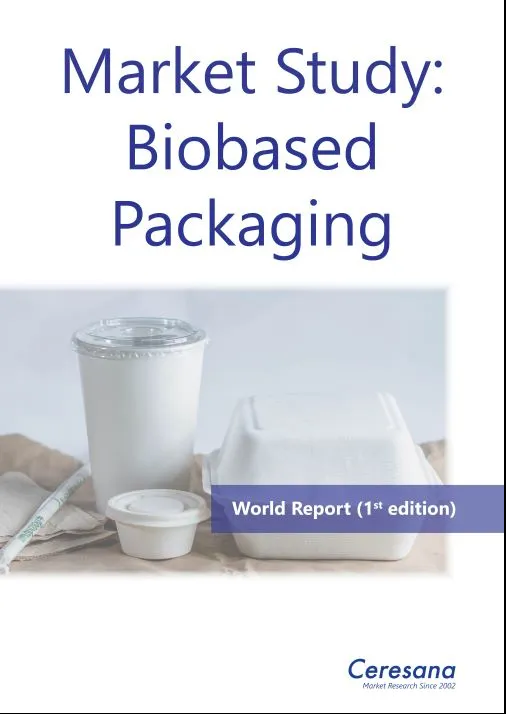
Are bioplastic bags compostable and can they be disposed of along with organic waste? In some places, there is a passionate debate about how environmentally friendly bioplastics really are. But that doesn’t change the fact that more and more films, containers, bottles and cups of all kinds, closures and lids, as well as labels, adhesive tapes and loose-fill packaging chips are being produced from biobased and/or biodegradable plastics. Ceresana analyzed the global market for packaging materials made from biopolymers: The analysts expect revenues generated with these to increase to around USD 31.4 billion by 2032.
Innovative and Dynamic Segment of the Plastics Market
Short-life packaging is by far the most important application for bioplastics, although they are also increasingly found in long-life high-performance products. In the context of bioeconomy and sustainable circular economy, biopolymers are associated with the hope of climate protection, non-toxic and environmentally friendly products, but also independence from fossil raw materials and new opportunities for agriculture and economically weak regions. Polylactic acid (PLA), mostly derived from plant starch, is currently the most important bioplastic on the packaging market with a share of 28%. Packaging made from biobased plastics that are not biodegradable, for example polyethylene and PET made from sugarcane ethanol, follow in second place. Ceresana expects the highest growth for PHA bioplastics (polyhydroxyalkanoates): Revenues generated with these biopolyesters formed by bacteria, are expected to increase by 19.4% by 2032.
Biobased Packaging for Food, Cosmetics and Pharmaceuticals
The current market report from Ceresana analyzes the development of the use of bioplastics for packaging in the various sales markets. The most important sales market in 2022 was the “food and beverages” area, which accounted for almost 61% of all packaging. Bioplastics are increasingly needed not only for bread bags and salad freshness films, but also for dairy products, chilled and frozen foods, ready-made meals and convenience foods, spreads, sauces and condiments, bottles and containers in the beverage segment. However, Ceresana expects the highest volume growth in the “cosmetics and pharma” area: 11.4% per year. This includes packaging for shampoos, shower gels, creams, lotions, makeup, liquid soap or other personal care items, but also packaging for pharmaceutical products. Asia currently accounts for around 38% of the total market for bioplastic packaging – closely followed by Europe.

The Study in Short:
Chapter 1 of the study provides a comprehensive presentation and analysis of the global market for packaging made from bioplastics – including forecasts up to 2032: the development of both demand (tonnes) and revenue (USD and EUR) is given for each world region. In addition, the various packaging types, application areas and product types are examined individually. Rigid packaging (for example bottles, cans and containers) and flexible packaging (bags, sacks, pouches) are covered separately.
The following applications for packaging made of bioplastics are considered:
- Food and beverages
- Consumer goods
- Cosmetics and pharma
- Other packaging areas
The packaging market is broken down for the various types of bioplastics for the regions of Europe, North America, Asia-Pacific and the “Rest of the World”:
- Polylactic acid (PLA)
- Starch-based plastics
- Polyhydroxyalkanoates (PHA)
- Other biodegradable plastics
- Biobased but non-biodegradable plastics
Chapter 2 considers the 11 most important sales countries for packaging made from bioplastics individually: Germany, France, the United Kingdom, Italy, the Netherlands, Spain, the USA, China, Japan, South Korea and Taiwan. In each case, the following are presented: Demand and revenue, demand for the individual application areas and demand per product type.
Chapter 3 provides useful company profiles of the top bioplastic packaging manufacturers, categorized by contact details, revenue, profit, product range, production facilities and brief profile. Detailed profiles are provided by 54 manufacturers, e.g. Alpagro Packaging, Amcor Limited, DSM NV, Innovia Films Ltd, Mitsubishi Chemical Corporation, Mondi plc, Sealed Air und Taghleef Industries.
Scope of the Report:
| Attributes | Details |
| Base Year | 2022 |
| Trend Period | 2020 – 2032 |
| Forecast Period | 2023 – 2032 |
| Pages | 210 |
| Application Areas | Food and Beverages, Consumer Goods, Cosmetics and Pharma, Other Packaging Areas |
| Product Groups | Polylactic Acid (PLA), Starch-Based Plastics, Polyhydroxyalkanoates (PHA), Other Biodegradable Plastics, Biobased but Non-Biodegradable Plastics |
| Company Profiles | Alpagro Packaging, Amcor Limited, DSM NV, Innovia Films Ltd, Mitsubishi Chemical Corporation, Mondi plc, Sealed Air und Taghleef Industries. (Selection) |
| Edition | 1st edition |
| Publication | April 2023 |
FAQs
How will sales generated with biobased packaging develop by 2023?
We expect sales to grow to around USD 31.4 billion by 2032.
Which bioplastics are expected to see the highest growth?
At 19.4%, Ceresana expects the highest growth for PHA bioplastics (polyhydroxyalkanoates).
Which sales market had the highest demand for biobased packaging?
The most important sales market in 2022 was the “food and beverages” area, which accounted for almost 61% of all packaging.
Source
Ceresana, press release, 2023-04-27.
Supplier
Alpagro Packaging
Amcor Ltd.
Ceresana Research
DSM
Innovia Films
Mitsubishi Chemical
Mondi Group
Sealed Air - SEE
Taghleef Industries (Ti)
Share
Renewable Carbon News – Daily Newsletter
Subscribe to our daily email newsletter – the world's leading newsletter on renewable materials and chemicals













